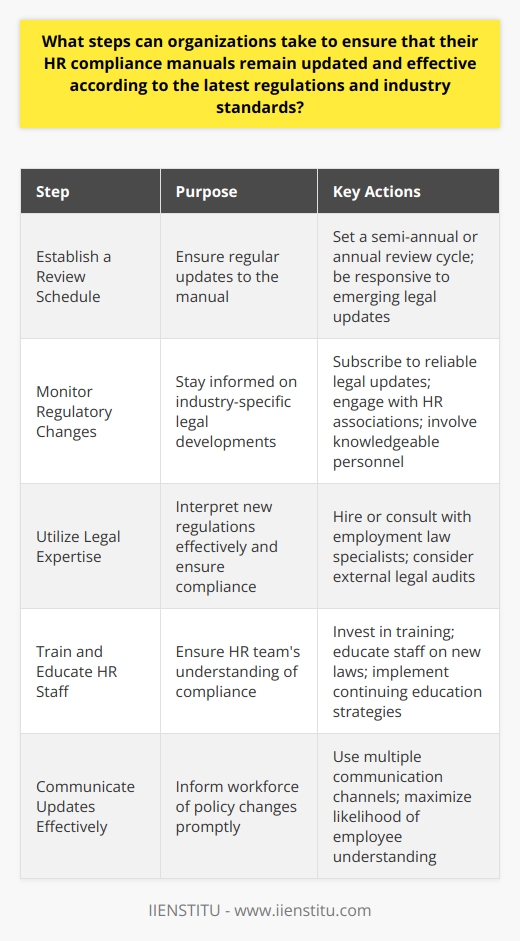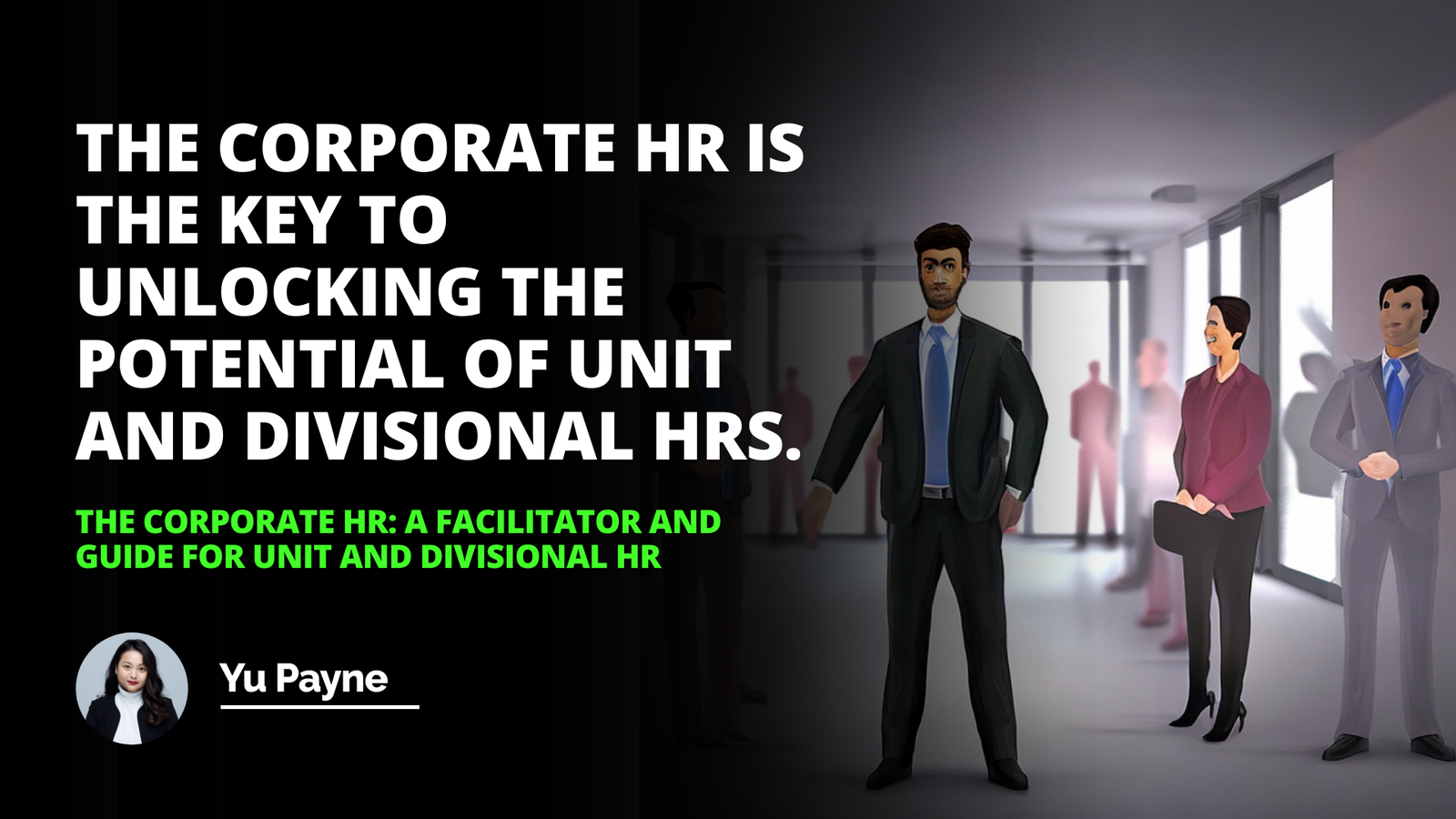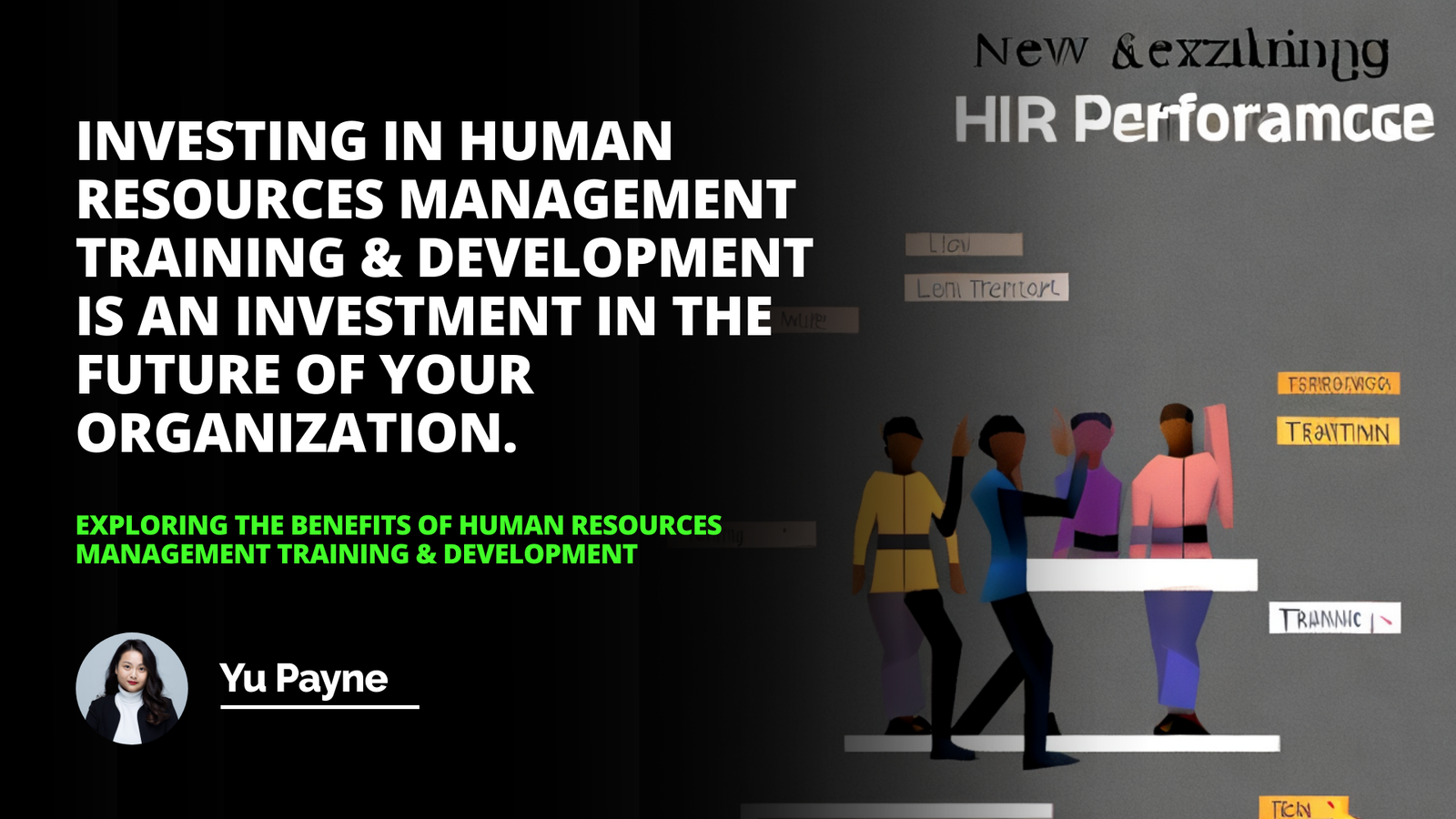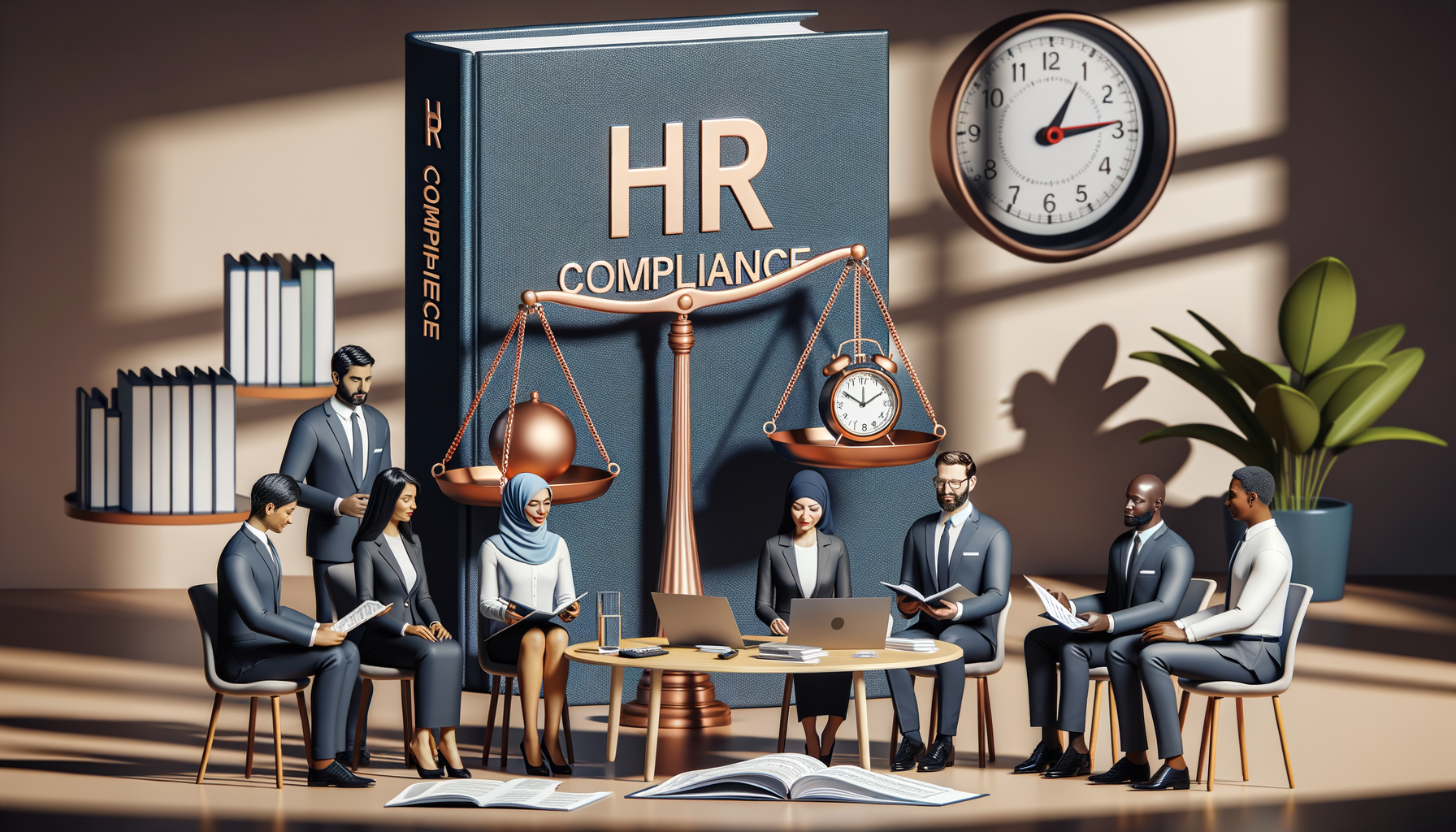
In an era marked by rapidly evolving labor laws and heightened regulatory scrutiny, the importance of an HR Compliance Manual cannot be overstated. At the very core of its function, the Human Resources (HR) department operates as the guardian of compliance, tasked with the intricate job of ensuring that an organization adheres to myriad employment regulations.
This introductory segment sets the stage for a multifaceted discussion on why HR Compliance Manuals are indispensable tools in sustaining business excellence. Fusing theoretical insight and practical applications, this article aims to serve as a beacon for HR professionals and business leaders desiring to solidify their compliance frameworks.
Why HR Compliance Manuals are Essential
The perils of non-compliance in the realm of human resources are vast and varied, with possible consequences ranging from costly legal disputes to damaging repercussions for an organization's reputation. A robust HR Compliance Manual serves as the organization's first line of defense by codifying practices, procedures, and expectations which align with legal standards. It provides a structured approach by which companies can preemptively identify and mitigate against HR-related risks.
HR certification courses often emphasize the pivotal role that HR Compliance Manuals play in safeguarding against such vulnerabilities. They underscore the fact that effective manuals are not simply repositories of regulations, but dynamic resources which translate complex legal requirements into actionable organizational policies.
Reinforcing this notion, companies that invest in comprehensive certificate courses online for HR professionals witness a sharpening of the competencies required to navigate the complexities of labor law.
Real-world examples abound where the absence of well-conceived HR Compliance Manuals resulted in dire consequences for companies. Consider a scenario where a lack of clear anti-discrimination policies led to unchecked workplace behavior, culminating in lawsuits that drained resources and eroded employee morale.
Conversely, organizations equipped with meticulously crafted manuals managed to thwart potentially deleterious situations by adhering to established protocols, demonstrating the indispensability of these documents.
Understanding Key Components of HR Compliance Manuals
An HR Compliance Manual typically encompasses various sections, each pivotal in painting a comprehensive picture of an organization’s stance on compliance. These sections may include employment policies, procedures for grievance handling, codes of conduct, and detailed steps for legal and regulatory adherence, thus creating a holistic guide for the workforce.
Each section is an essential cog, helping to maintain a well-oiled compliance machine. For instance, the segment detailing disciplinary procedures becomes a blueprint for fair and consistent handling of employee misconduct. It cascels through scenarios ranging from minor infractions to grievous offenses, articulating the seriousness with which the company takes compliance. Understanding what each section achieves individually—and how they interlink—fortifies the organization’s ethical and legal foundations.
While crafting these sections, HR leaders must pay attention to clarity, practicality, and accessibility. It is crucial to articulate procedures and policies in a manner that is understandable to employees at all levels. Moreover, these manuals must not merely be repositories of rules but should clearly delineate the rationale behind protocols, empowering employees to appreciate the importance of compliance. Thus, preparation of each section should be undertaken with great care, striving for scalability and applicability across diverse workplace scenarios.
Steps to Create an HR Compliance Manual
Embarking on the creation of an HR Compliance Manual is no small endeavor; it requires strategy, dedication, and an eye for detail. The process begins with the gathering of all relevant employment laws and regulations that apply to the organization, which could be an intricate matrix at varying jurisdictions. A thorough understanding of these legal frameworks lays the groundwork for subsequent policy development.
Drawing from insights provided by expert-led HR certification courses, it is advisable to conduct extensive research and, when necessary, consult with employment law experts. This step is critical in ensuring that all areas of potential risk are covered and that the policies developed are not only compliant with current legislation but also anticipate future legal trends. It is this depth of research and consultation that distinguishes an expertly crafted manual from its mediocre counterparts.
Once the content of the manual is sculpted, the key is to make it digestible and pertinent to every employee. Plain language, clear headings, and a logical structure contribute to a user-oriented manual that demystifies compliance. Moreover, recognizing that laws and organizational contexts evolve, the manual must be reviewed and updated regularly, engaging a team to monitor changes in legal statutes and workplace dynamics. This aspect is a testament to the manual's living nature, an essential characteristic for maintaining relevance and adhering to best practices.
How to Leverage HR Compliance Manuals for Employee Training
The influence of a well-structured HR Compliance Manual extends beyond serving as a reference point; it is also a cornerstone for effective employee training programs. Its very essence molds the core of onboarding materials, integrating compliance into the fabric of organizational culture from employees’ initial interaction with the company.
With HR manuals being pivotal in delineating acceptable and exemplary workplace behavior, it is prudent to use these documents as the backbone for training modules. In doing so, employees are not simply inducted into the company but are immersed into a culture steeped in compliance consciousness from the outset. This proactive approach reduces ambiguity and sets clear expectations regarding conduct.
Case studies illuminate the practical benefits of intertwining compliance manuals with employee training. Corporations that have adopted this method report a reduction in workplace incidents and enhanced employee engagement. This trend points to the intrinsic value of compliance manuals beyond their role as repositories of guidelines, highlighting their potential as foundational tools in fostering a legally astute workforce.
Challenges and Solutions in Implementing HR Compliance Manuals
Implementing an HR Compliance Manual is not without its hurdles. Overwhelmingly dense legal jargon can render documents inaccessible, employees may resist new procedures, and keeping content current in the face of changing laws presents ongoing challenges. Businesses must rise to meet these challenges with strategic planning and deliberate action.
To combat these obstacles, clarity, consistency, and communication are key. Ensuring manuals are written in plain language and presented in an engaging format invites greater staff engagement. By incorporating feedback mechanisms, businesses can refine the manual's usability and foster a culture of continuous improvement. Regular training sessions maintain the manual’s presence in daily operations, embedding its principles into the company's ethos.
Real-life success stories often emanate from businesses that have identified specific challenges and crafted tailored solutions. These organizations have not only transformed potential weaknesses into strengths but have also set new industry benchmarks for compliance. By viewing the implementation of a manual not as a one-time event but as an evolving process, these companies have nurtured adaptable and compliant work environments.
Role of Digital Platforms in HR Compliance
In an increasingly digital world, the significance of electronic platforms in achieving and maintaining HR compliance cannot be understated. These platforms offer novel ways to disseminate information, train employees, and monitor adherence to policies outlined in HR Compliance Manuals. They foster real-time updates, engage users interactively, and ensure a level of consistency unattainable by traditional paper manuals.
Organizations that harness the power of digital tools often find themselves at an advantage. Online certificate courses online can deliver compulsory compliance training to a geographically dispersed workforce, while digital handbooks can be updated swiftly as laws evolve. Case studies exhibit companies that have successfully integrated digital platforms into their HR strategies, reaping the rewards of greater efficiency and compliance.
It is imperative that companies not only consider digital avenues for HR compliance but actively pursue them. In doing so, they can leverage the ubiquity of technology to support a robust compliance infrastructure and reduce the risk of non-compliance during audits. The integration of digital solutions underscores a forward-thinking approach to HR that resonates with a tech-savvy workforce and prepares organizations for the challenges of the digital age.
In conclusion, the HR Compliance Manual is a vital tool for sustaining business excellence through proactive management of HR compliance. This document acts as a blueprint, guiding businesses through the labyrinth of regulations and fostering a culture of legal and ethical integrity. The need for these manuals to be user-friendly, up-to-date, and reflective of best practices cannot be overstated.
The continuous journey of updating and implementing the HR Compliance Manual underscores the dynamic nature of compliance. Whether through traditional methods or digital innovation, staying apprised of changes and engaging the workforce in compliance matters is a unending mission.
Taking an expert approach in preparing and maintaining these manuals will pay dividends in minimizing risk, enhancing employee relations, and upholding the organization's reputation. May this guide serve as a lodestar for those committed to the pursuit of HR excellence through stringent compliance and inspired leadership.
Frequently Asked Questions
What are the critical components of an effective HR compliance manual?
Introduction
HR compliance manuals serve as vital guides. They outline policies, laws, and procedures. These manuals aim to ensure lawful, fair, and consistent management. They protect organizations and inform employees. The creation of an effective manual involves several critical components.
Legal Foundations
Legislation Awareness
A manual must reflect current laws. It should cover federal, state, and local regulations. This ensures legal compliance and reduces litigation risks.
Policy Updates
Laws change regularly. Manuals require continuous updates. This ensures ongoing compliance.
Company Policies and Procedures
Clear Expectations
Employees need clear guidelines. These should outline expected behaviors and consequences. Clear rules promote a respectful workplace.
Consistent Procedures
Fair treatment is crucial. Defined procedures ensure consistent application. This builds trust and fairness.
Employee Rights and Obligations
Knowledge of Rights
Every employee must understand their rights. These include discrimination, harassment, and workplace safety. Awareness promotes a positive work environment.
Understanding Obligations
Employees also have responsibilities. They must know these obligations. Comprehension ensures smooth operations and accountability.
Training and Development
Regular Training
Continuous learning is essential. Staff should receive training on compliance topics. This fosters a culture of awareness.
Accessible Resources
Manuals should be easy to access. Resources must be available for reference. This encourages compliance and understanding.
Reporting and Enforcement
Clear Reporting Channels
Employees must know how to report issues. Clear channels prevent misconduct and promote transparency.
Enforcement Mechanisms
A manual must outline enforcement strategies. Consistent enforcement demonstrates a commitment to compliance.
Recordkeeping and Monitoring
Accurate Records
Documentation is key. It must be thorough and accurate. Proper records protect the organization and support fairness.
Continuous Monitoring
Regular checks ensure adherence. They also identify areas for improvement. Monitoring demonstrates dedication to compliance.
Effective HR compliance manuals are non-negotiable. They are essential tools for risk management. They guide ethical conduct and legal compliance. Every component is crucial. Together, they create a robust framework for organizational integrity. With these elements in place, HR manuals serve their purpose effectively.
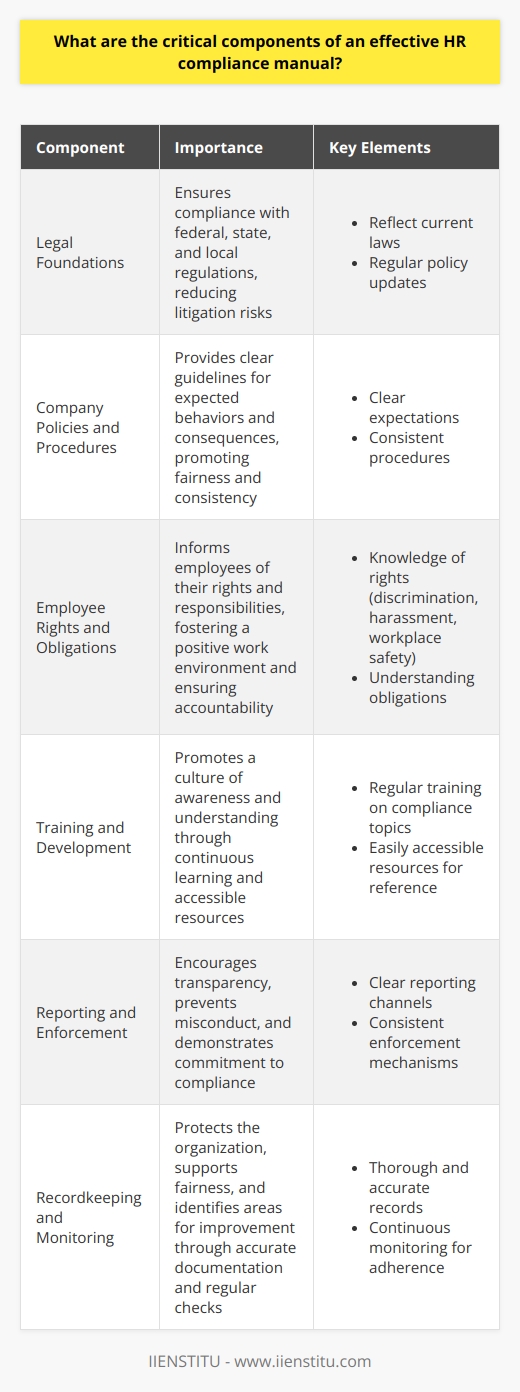
How does a well-structured HR compliance manual contribute towards business excellence?
Introduction
A well-crafted HR compliance manual stands pivotal. It underpins myriad facets of business excellence. Clarity, consistency, legal adherence, and risk mitigation bolster. Let us explore how.
Legal Compliance and Risk Mitigation
Legal frameworks govern HR practices extensively. A precise manual outlines statutory obligations. It helps prevent legal transgressions. This action grounds an environment of compliance. Such an environment nurtures trust. Employees and stakeholders gain confidence. Moreover, it averts costly legal battles. It preserves resources for strategic endeavors.
Employee Alignment and Productivity
Clear policies ensure employee alignment. Firm guidelines and expectations resonate across the board. Thus, productivity amplifies. A shared understanding of duties and rights grows. This commonality generates coherent workplace behaviors.
Consistency in Decision Making
A detailed manual provides a robust decision-making framework. Managers yield greater consistency in actions. This consistency fosters fairness. It curtails partiality. Employees perceive the workplace as just. Morale naturally elevates.
Efficient Resolution of Workplace Issues
When disputes arise, a manual offers quick reference. It directs to efficient resolution processes. This expedites problem-solving. Turnaround times for addressing grievances shrink. Prompt action instills a sense of responsiveness. Employee satisfaction and retention benefit as a result.
Streamlining Onboarding and Training
Onboarding processes leverage a sturdy manual. New hires assimilate rapidly. They appreciate a well-outlined company culture and expectations. Correspondingly, training programs draw from the same manual. They become more effective and uniform.
Cultivating a Positive Workplace Culture
The compliance manual encapsulates ethical standards. It instills values and principles. Employees mirror these cultural benchmarks. A positive, compliant culture emanates. It acts as a bedrock for sustainable business practices.
Facilitating Audit and Assessment
Regular audits require a point of reference. The manual serves this need. It enables straightforward assessments. It thus guarantees the enterprise complies with pertinent regulations. Readiness for audits implies operational excellence.
In summary, a deftly structured HR compliance manual delivers significantly. It lays the foundation for comprehensive business excellence. It permeates legal adherence, employee engagement, decision-making consistency, dispute resolution, onboarding processes, workplace culture, and audit readiness. Prioritizing its development thus becomes not just necessary but critical for the thriving business.
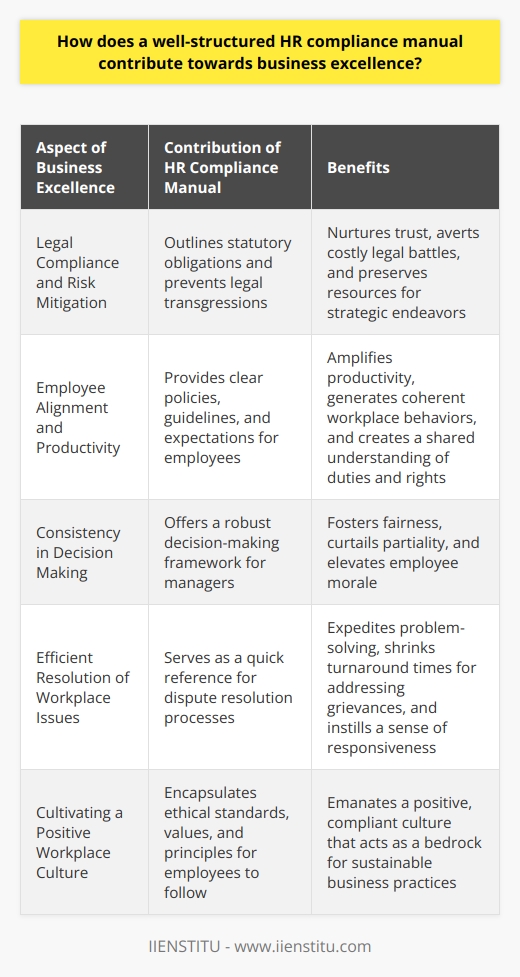
What steps can organizations take to ensure that their HR compliance manuals remain updated and effective according to the latest regulations and industry standards?
HR Compliance Manuals: Ensuring Up-to-Date Practices
Organizations must prioritize HR compliance. This ensures operations align with legal requirements and best practices. Compliance manuals serve as vital references for this. But, these resources can quickly become outdated. Regular updates are critical, so they continue supporting organizational needs.
Establish a Review Schedule
Set a regular review cycle for your manuals. This could be semi-annual or annual, depending on the industry's pace of change. Be flexible and responsive to emerging legal updates.
Monitor Regulatory Changes
Stay informed on regulatory changes. Subscribe to legal updates within your industry. Engage with HR associations that provide these updates. Make sure that these sources are reliable and authoritative. Involve knowledgeable personnel in monitoring tasks. They should understand how changes impact your organization.
Utilize Legal Expertise
Hire or consult with legal professionals specializing in employment law. They interpret new regulations effectively. Their insights ensure that your manual reflects the current legal landscape. Consider external legal audits of your HR policies. These audits often reveal areas needing updates.
Train and Educate HR Staff
Invest in training for your HR team. They must understand compliance fully. Educate them on new laws and how these affect the manual. Implement continuing education strategies to keep staff informed.
Embrace Technology Solutions
Consider software that tracks legal changes. These systems can alert you to relevant updates. Use technology to streamline the update process. Digital manuals can be edited more efficiently than printed documents. Choose platforms known for their robust security measures.
Get Feedback from Employees
Include employees in the updating process. Solicit their feedback on the practical aspects of policies. They provide insights that legal or HR professionals might miss. Implement their suggestions when it makes the manual more applicable.
Document All Changes
Keep records of all adjustments made to the manual. Document why you made these changes. This helps track compliance history. It also aids in defending against potential legal challenges.
Communicate Updates Effectively
Inform your workforce of any updates promptly. Use multiple communication channels. This maximizes the likelihood that employees will understand the new policies.
Review Best Industry Practices
Look at what leading organizations are doing. Many industries have standard-setting bodies that offer guidance. Align your policies with recognized best practices whenever possible.
Evaluate Impact on Company Culture
Assess how compliance changes might affect your company's culture. Ensure that your policies support a constructive and ethical workplace. Respect for employee well-being should remain a priority.
Test Policy Effectiveness
Implement pilot programs for new policies when possible. Gather data on their effectiveness. This approach helps refine the manual before broad implementation.
By applying these steps diligently, organizations can keep their HR compliance manuals not just updated, but also effective. The aim is always to make compliance a living part of company operations. It should evolve as the legal and industrial landscapes change.
